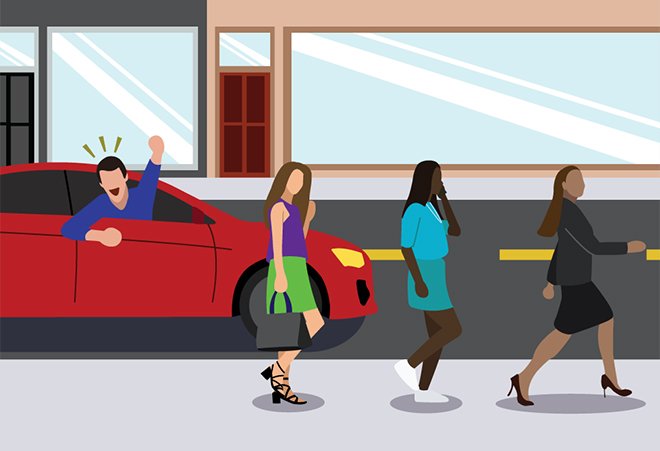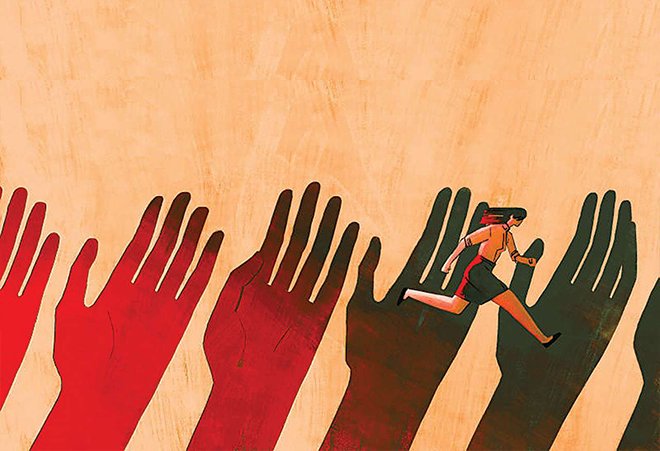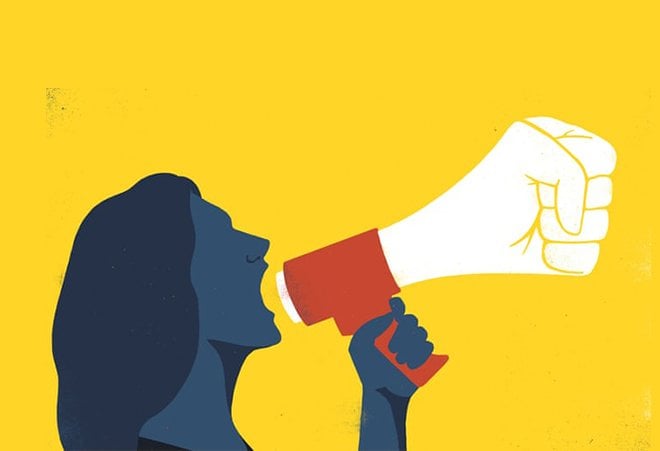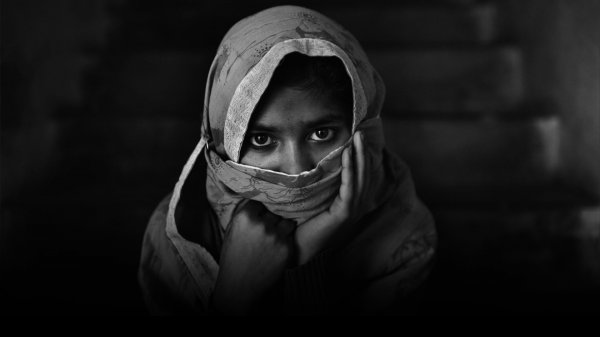
“Naaangiii!?!” the motorcyclist called, swerving dangerously towards the pavement. His companion turned his head, grinned like a Cheshire cat, and watched for my response with glee.
This was just the first of three ‘hit and runs’ that occurred within a span of ten minutes.
Stunned out of an otherwise peaceful Sunday walk, I was angry but too startled to do much. Shock aside, confronting harassment each time would be exhausting — in Sri Lanka, over one in ten women are harassed daily.
As I continued to walk, irritated now, my mind flashed back to a 2014 advert by the Urban Development Authority that represented government aspirations for the city of Colombo. A young girl plays among flowers and butterflies. She skips joyfully past pristine landmarks: Racecourse, Waters Edge. Not a threat in sight.
“Is the state gaslighting us?” I ask myself, as I visualise the advert again — this time giggling motorcyclists veer recklessly through the city, taunting that young girl.
Rates of harassment in Sri Lanka — where over 90% of women are harassed on public transport — are higher than those recorded in India, Pakistan and Nepal. This sheer frequency means that women experience a walk or a bus ride very differently than men do. We scan for allies, threats, and exit routes. There’s a nagging hypervigilance as we move, targets on our backs. Sadly, we can also become accustomed to the cat-calling, groping and indecent exposure that characterise a daily commute.

My shock at being catcalled had hardly subsided when a trucker decided to roll out his tongue — “Baby, hello!” This time, I was better prepared. No sooner did he suggestively lick his lips than my middle finger shot into the air. I am not sure if the trucker felt guilty about his behaviour, or whether he was titillated. I quickened my pace.
But moments later, almost reflexively, my rage dissolved into self-doubt. I had now encountered two street harassers in quick succession. I scanned my attire, to confirm that there was nothing wrong with the way that I was dressed. That, in other words, I wasn’t breaking an unwritten social code or asking for it in any way.
It was a few moments before I realised that I had just victim-blamed myself. Even if I was dressed ‘appropriately’ (whatever that means), why should it matter? Dressing ‘appropriately’, exposing less skin, walking in groups or with a male may reduce the incidence and intensity of harassment, but it comes at the cost of female autonomy and will not eliminate the practice.
It may be mildly comforting to imagine that there’s something we can do to reduce street harassment — whether that’s getting home early or dressing conservatively. But by thinking that way, we hold women responsible for harassment that is most definitely not their fault, and shift accountability away from the true perpetrators. In doing so, we fail to vocalise how harassment makes us feel and lose the opportunity to reform the systems that foster, facilitate and perpetuate it.
Harassment — a term that only gained currency in the ’70s — is too often considered a problem that women must navigate, manage and take responsibility for. But by tolerating casual sexism, argues Ambika Satkunathan, a former member of the Human Rights Commission of Sri Lanka (HRCSL), we normalise it: “You become complicit by what you ignore, what you tolerate and what you accept because it is convenient or beneficial to you.”
It is disturbing that for women to be safe from harassment, they must either be shepherded around when in public or stay behind purdah. These options are both impractical and unjust. Women already drop out of the economy at alarming rates in Sri Lanka, which has the 14th largest gender gap in labour force participation globally — and asking them to stay at home to avoid potential harassers would only add to these numbers.
Whenever women occupy public spaces, or are visible in spaces of modernity — whether it is the streets, public office, or social media — they are harassed. Sri Lanka’s recent #MeToo movement, which focused on the harassment of female journalists in newsrooms, demonstrated how even ‘progressive’ spaces can become the site of female objectification and harassment. Historically, the visibility of street harassment (and resistance to it) neatly coincides with the growth of city centres where commerce, retail, and politics merge. When women enter public spaces, they are treated as if they have chosen and endorsed harassment, as if harassment is the tradeoff they must pay to partake in a modern economy and polity.

But this lies in contradiction to the lengths that women go to in order to avoid harassment. Social activist Ashila Dandeniya, who works with garment factory workers in the Katunayake free trade zone, describes how one woman preferred to walk 1.5 kilometres to work following an incident of harassment rather than take her regular bus or stay at home. Some victims of repeated harassment even change where they live to avoid harassment.
As I reflected on self-blame and street harassment, I heard the “sssss…ssss” of my third harasser that afternoon. Looking up, I saw a passenger stick his head out of a car, a smug grin splayed across his face as if it was he who had invented this method of demanding a woman’s attention. My middle finger leapt into the air again, possessed. I felt my eyeballs flaring, possibly departing their sockets. A furious scowl and deeply furrowed eyebrows left no doubt about how I felt. I lowered my mask, mouthed “What’s wrong with you?” and continued to walk.
The passenger, in turn, seemed distressed. It was almost as if he was not expecting his Sunday afternoon to be disturbed in this manner. I felt his eyes on me as the traffic lights changed. As the car rolled by, I saw that his face was now animated by what seemed like hurt. How many such men believe their harassment is a compliment?
Expressions of sexual attraction and acts of sexual harassment are not the same. The harm that stems from the latter arises from inherent sexual objectification. A woman experiences harassment when she is regarded as an inanimate object, body, or animal, without autonomy or agency, and thus when her status as a moral equal has been degraded.
The ‘hit-on and run’ comment that women regularly receive from street harassers is a perfect example of sexual objectification. The opportunist is safely ensconced in his vehicle and well-positioned to flee should he be confronted. He does not care about how the exchange is received. The ‘object’ of these comments has been reduced to body and physical appearance, their subjectivity and agency voided. Unlike expressions of sexual attraction, sexual harassment is never about us. It is about them: their gaze, their desire, their power and their ability to impose sexual desire with impunity.
Compared to the other kinds of violence women face, street harassment can appear lower on the spectrum of harm. But as Satkunathan argues, we need to start seeing discrimination, however ‘harmless’ it may appear, as part of a patriarchal continuum — as part of an entire system that oppresses and marginalises women. And there is, indeed, something uncannily similar about the men I encountered in those vehicles to those that would commit grave sexual violence.
For one, the same culture of objectification that facilitates street harassment is operational in other forms of violence against women. Rapists, assaulters and other sexual predators all make the cardinal error of violating consent and objectifying women in the same way the street harasser does — stripping them of agency, subjectivity, autonomy, self-determination and feelings that must be accounted for. Each also has remarkable confidence. I can get away with it. Isn’t that the same logic that animates sexual predators who pick on women they perceive as young, vulnerable or less powerful? Or that characterises the actions of predators harassing family members whose circumstances they are familiar with? In one case the predator has a literal vehicle, in the other the vehicle is his age, status, or relationship to the victim.

The frequency of street harassment in Sri Lanka signposts a broader culture of sexual objectification and impunity — the same culture that enables grave sexual violence. In turn, the threat of graver violence always underlies a seemingly ‘harmless’ or quotidian experience of harassment; another reason why ‘harmless’ harassment cannot be divorced from the context and power dynamic in which it occurs.
For Sri Lankan women, this gendered context is one in which about a quarter of women have experienced physical and/or sexual violence. It is a context in which there were 300 recorded cases of rape of adult women and 1,653 recorded cases of statutory rape in the year 2020. That same year the police filed complaints for less than 10 per cent of rape cases, leading to fewer instances of prosecution and no convictions. In Sri Lanka, a rape case usually takes over five years between incident and indictment and judges often deliver suspended sentences to the guilty. The context therefore is one in which impunity for violence against women is deeply entrenched.
Those who might help enforce the law — drivers, bus conductors and bystanders — are not really sensitised to harassment. Dandeniya recalls cases in which a bus conductor and van driver were themselves harassers. When women approach the police, she continues, the harassers are dismissed as ‘mental’ or ‘crazy’ and women are asked to discount their lewd behaviour. Aside from court delays, women face the risk of retraumatisation, challenges collecting medico-legal evidence and threats to their safety when they pursue justice through the courts. Such difficulties are exacerbated wherever alleged perpetrators belong to powerful state institutions, like the military or police, or when survivors are those with disabilities or those from oppressed castes, (ethnic or sexual) minority groups or low-income households.
When I got home that Sunday, I realised that I had only been on the street for ten minutes and had confronted a sexual predator once every three minutes. If I could blame myself when confronted with an unknown street harasser, how do women stand up to harassers they know, those who wield power and influence or those they are expected to trust, like relatives, clergy-members or doctors? How do we expect women to stand up to their employers or senior employees who share the same workspaces? How do we expect women to stand up to respected members of our community who can shift public narratives with ease when survivors risk reliving trauma, the loss of livelihoods and social outcasting? If we can’t hold perpetrators accountable for street harassment, where the costs of protesting are relatively low, how do we expect survivors to resist stigma and acknowledge rape, domestic violence and sexual abuse?

Resisting hit-(on) and runners requires collective or state action. Long overdue improvements in public transport could reduce traffic congestion, lower commute time and decrease the incidence of harassment. Technology could be leveraged in public transport design, for example, via CCTV systems in bus and train stations or through a practical and dedicated app for reporting harassment. And while technology isn’t always the panacea it is branded to be, mobile phones can be used to document incidents, if women feel comfortable doing so. When I pointed my phone at a harasser who decided to honk and ‘thumbs-up’ me recently, he registered my protest more seriously. “Why are you taking my photo?” he whined. “Why are you harassing women?” I retorted.
But there are also immediate ways in which the state can build awareness and enforce the law. This government has already amply demonstrated its capacity to raise awareness about COVID-19 and arrest citizens violating quarantine rules. Harassment occurs in epidemic proportions and threatens the security, mobility and health of a large segment of Sri Lanka’s population. It is associated with “increased risk of anxiety, depression, and post-traumatic stress disorder, as well as diminished self-esteem, self-confidence, and psychological well-being.”
Social activists Dandeniya and Rashmini de Silva insist that we don’t rely on state initiative to formulate policies or change dysfunctional legal systems. They urge the adoption of a community-based approach and claim citizens can play a constructive role by intervening whenever someone is being harassed. Interventions don’t have to be violent or stressful; they can be as simple as asking the harasser for directions or the time to distract them. Street harassment is a plague and signals a broader cultural orientation towards sexual violence. When the costs of doing so are manageable, women and their allies need to work together to intervene, resist, and disrupt harassment from the ground up.



.png?w=600)




.jpg?w=600)